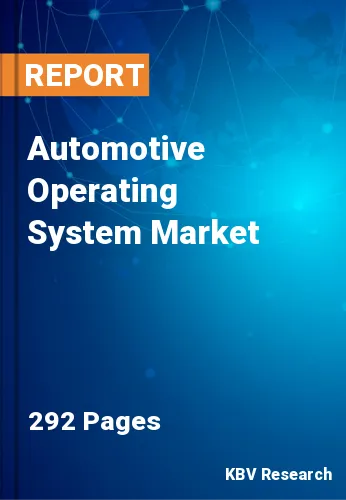
The Global Automotive Operating System Market size is expected to reach $22.5 billion by 2029, rising at a market growth of 9.1% CAGR during the forecast period.
An automotive operating system (automotive OS) is a platform for developing and managing all vehicle domain services and applications. It facilitates close, cross-company collaboration and comprises a software factory and a base layer. In addition, automotive OS is a framework for infotainment that automakers include in vehicles. Without a phone, drivers can use an interface made for the vehicle screen by downloading appropriate apps simply into their vehicles.
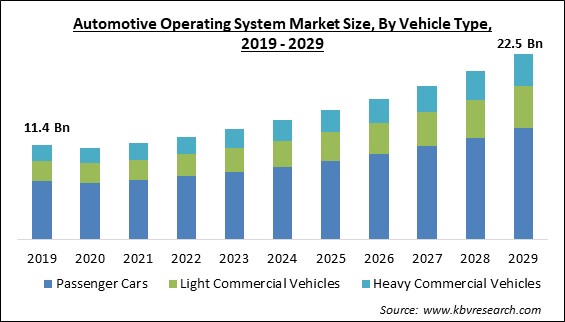
Every automotive OS differs significantly in terms of program size, functionality, complexity, the effort required for creation, needed hardware, lifetime maintenance, pricing, and support effort. A typical operating system might include as few as a few hundred lines of code or as many as tens of millions for popular OSes like Linux and Windows. The ecosystem and capabilities of the OS are also crucial for creating the software and app platforms needed for software-defined vehicles. For the finest OS to serve the expanding software-defined vehicles of the future, a sizable ecosystem and infrastructure are therefore necessary.
The OS kernel finds all the essential tools for controlling the software and hardware. The two primary methods of structuring the kernel are the monolithic kernel and the microkernel OS. All essential OS features, such as OS services and system calls, are in the kernel area under a monolithic design. The leading monolithic kernel operating system is Linux. A modest software platform called a hypervisor is used to manage many OS platforms as well as their apps. Infotainment and functional-safety features, such as a head-unit display (HUD) for a backup monitor, requires hypervisors.
Market growth and trends were significantly impacted by the COVID-19 pandemic. Yet the development of COVID-19 vaccinations was helpful for the car and transportation sectors. Following that, many companies began to resume production in areas worldwide where people had received vaccines while taking strict safety measures to protect employees. In addition, significant businesses that provide innovative technology & solutions to OEMs have also made a significant effort to repair the damage brought on by COVID-19 using a variety of strategies. Consequently, the rise of the automotive industry is expected to fuel the market's growth in the years to come.
The cockpit has intelligent sensing and interaction capabilities owing to the cockpit domain controller. This contributes to a better interactive experience for users. The significance of cockpit domain controllers is anticipated to keep increasing due to evolving in-vehicle infotainment and expanding ADAS feature adoption. The Real-Time Operating System (RTOS), virtual machines, GPU, general-purpose OS (Android and Linux), and CPU, among others, are needed by domain controllers for the cockpit domain to operate properly. Operating system demand will rise as a result. Considering all the aforementioned factors, the market for automotive operating system is expected to grow throughout the forecast period.
When compared to hardware-defined vehicles, software-defined vehicles provide several benefits. For example, telematics, car diagnostic, and other software changes involving vehicle entertainment systems will demand a visit to the dealership. However, with software-defined vehicles, users can download over-the-air (OTA) upgrades that address security patches, infotainment enhancements, and monitoring and tuning essential features like the powertrain and driving dynamics. The market for automotive operating systems will be driven by this increase in demand for software-defined vehicles throughout the forecast period.
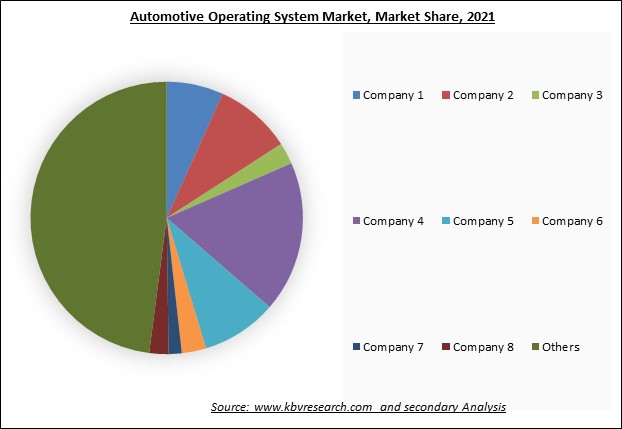
The leading players in the market are competing with diverse innovative offerings to remain competitive in the market. The illustration shows the percentage of revenue shared by some of the leading companies in the market. The leading players of the market are adopting various strategies in order to cater demand coming from the different industries. The key developmental strategies in the market is and Partnerships & Collaborations.
A cloudy image of the adoption of 5G technology is impeding the transformation of some conceptual advancements to on-the-ground use in developing nations as well as in the periphery and main cities of wealthy nations. Thus, a lack of consistent and seamless communication will limit the possibilities for ADAS features, infotainment systems, cockpit domains, etc. For instance, ADAS needs fundamental infrastructures like well-marked lanes, orderly roadways, and GPS connectivity to function properly. Furthermore, because of the poor network connectivity on highways, automobiles are not connected to cloud data or other vehicles. These constraints are anticipated to limit the market for automotive operating system' expansion prospects during the projected time.
Based on type, the automotive operating system market is categorized into QNX, Linux, Windows, Android, and others. The QNX segment garnered the highest revenue share in the automotive operating system market in 2022. Because of its compatibility with a wide range of hardware and support from industry-leading cluster UI frameworks, QNX has traditionally been one of the most popular OS among automakers. QNX is also utilized in several other applications, including ADAS features, cockpit controls, and in-car entertainment systems.
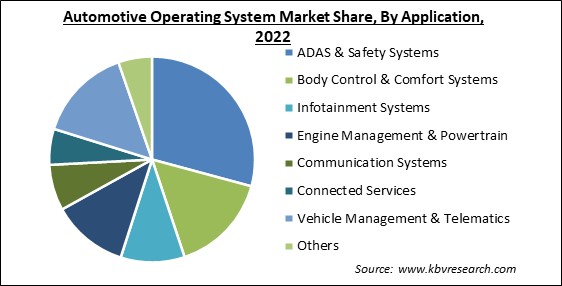
On the basis of vehicle type, the automotive operating system market is divided into passenger cars, light commercial vehicles, and heavy commercial vehicles. The light commercial vehicles (LCV) segment recorded a significant revenue share in the automotive operating system market in 2022. Van demand has historically been very strong in the logistics industry. In the developing market, automakers now provide more LCV models. Modern technologies for light commercial cars are increasingly in demand throughout many developed nations.
On the basis of application, the automotive operating system market is fragmented into ADAS & safety systems, body control & comfort systems, communication systems, connected services, infotainment systems, engine management & powertrain, vehicle management & telematics, and others. The body control & comfort systems segment acquired a substantial revenue share in the automotive operating system market in 2022. Energy flow can be controlled by a body control module, preventing overloading of the electrics caused by too many functions using a lot of energy at once. At any given time, the most crucial function receives the best energy possible and takes precedence over all other functions.
| Report Attribute | Details |
|---|---|
| Market size value in 2022 | USD 12.4 Billion |
| Market size forecast in 2029 | USD 22.5 Billion |
| Base Year | 2022 |
| Historical Period | 2019 to 2021 |
| Forecast Period | 2023 to 2029 |
| Revenue Growth Rate | CAGR of 9.1% from 2023 to 2029 |
| Number of Pages | 292 |
| Number of Table | 423 |
| Report coverage | Market Trends, Revenue Estimation and Forecast, Segmentation Analysis, Regional and Country Breakdown, Competitive Landscape, Companies Strategic Developments, Company Profiling |
| Segments covered | Vehicle Type, Application, Type, Region |
| Country scope | US, Canada, Mexico, Germany, UK, France, Russia, Spain, Italy, China, Japan, India, South Korea, Singapore, Malaysia, Brazil, Argentina, UAE, Saudi Arabia, South Africa, Nigeria |
| Growth Drivers |
|
| Restraints |
|
Region wise, the automotive operating system market is analyzed across North America, Europe, Asia Pacific, and LAMEA. The Asia Pacific segment garnered the largest revenue share in the automotive operating system market in 2022. This region has been a center for vehicle manufacturing in recent years. The four countries with the biggest shares of manufacture and sales of automobiles are India, Japan, China, and South Korea. Due to this, the volume of vehicles produced has increased over time, satisfying domestic and international demand.
Free Valuable Insights: Global Automotive Operating System Market size to reach USD 22.5 Billion by 2029
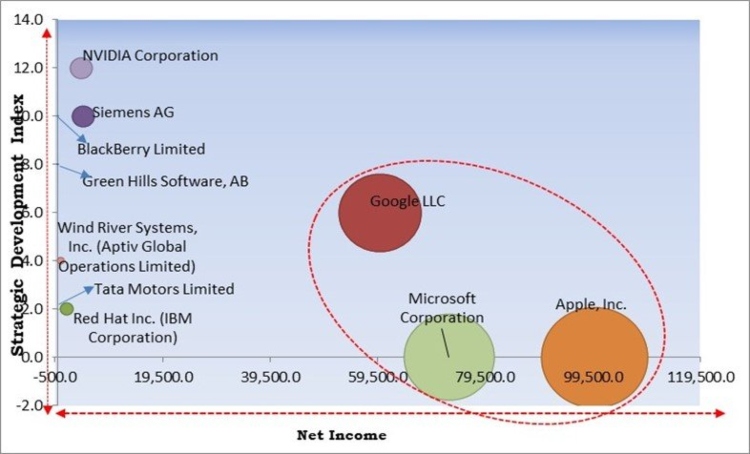
The major strategies followed by the market participants are Partnerships. Based on the Analysis presented in the Cardinal matrix; Apple, Inc., Microsoft Corporation and Google LLC are the forerunners in the Automotive Operating System Market. Companies such as NVIDIA Corporation, Siemens AG, BlackBerry Limited are some of the key innovators in Automotive Operating System Market.
The market research report covers the analysis of key stake holders of the market. Key companies profiled in the report include Apple, Inc., NVIDIA Corporation, Google LLC (Alphabet, Inc.), Red Hat Inc. (IBM Corporation), Microsoft Corporation, Siemens AG, BlackBerry Limited, Tata Motors Limited (Tata Group), Wind River Systems, Inc. (Aptiv Global Operations Limited) and Green Hills Software, AB.
By Vehicle Type
By Application
By Type
By Geography
The Market size is projected to reach USD 22.5 billion by 2029.
Introduction of vehicles defined by software are driving the market in coming years, however, Lack of basic and uninterrupted 4G/5G connectivity restraints the growth of the market.
Apple, Inc., NVIDIA Corporation, Google LLC (Alphabet, Inc.), Red Hat Inc. (IBM Corporation), Microsoft Corporation, Siemens AG, BlackBerry Limited, Tata Motors Limited (Tata Group), Wind River Systems, Inc. (Aptiv Global Operations Limited) and Green Hills Software, AB.
The Passenger Cars segment acquired maximum revenue share in the Global Automotive Operating System Market by Vehicle Type in 2022 thereby, achieving a market value of $13.5 billion by 2029.
The Asia Pacific market dominated the Market by Region in 2022, and would continue to be a dominant market till 2029; thereby, achieving a market value of $8.2 Billion by 2029.
Our team of dedicated experts can provide you with attractive expansion opportunities for your business.
